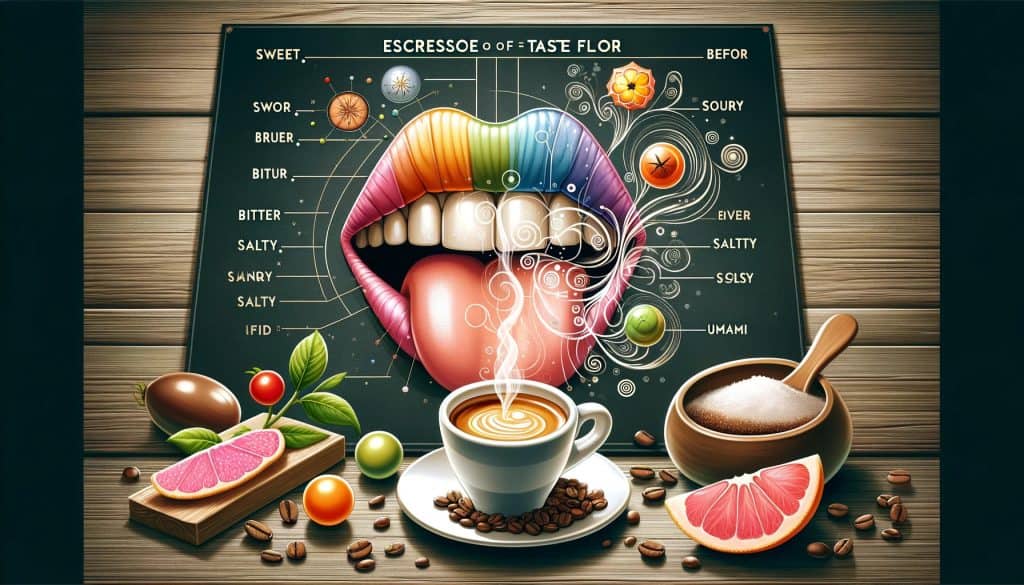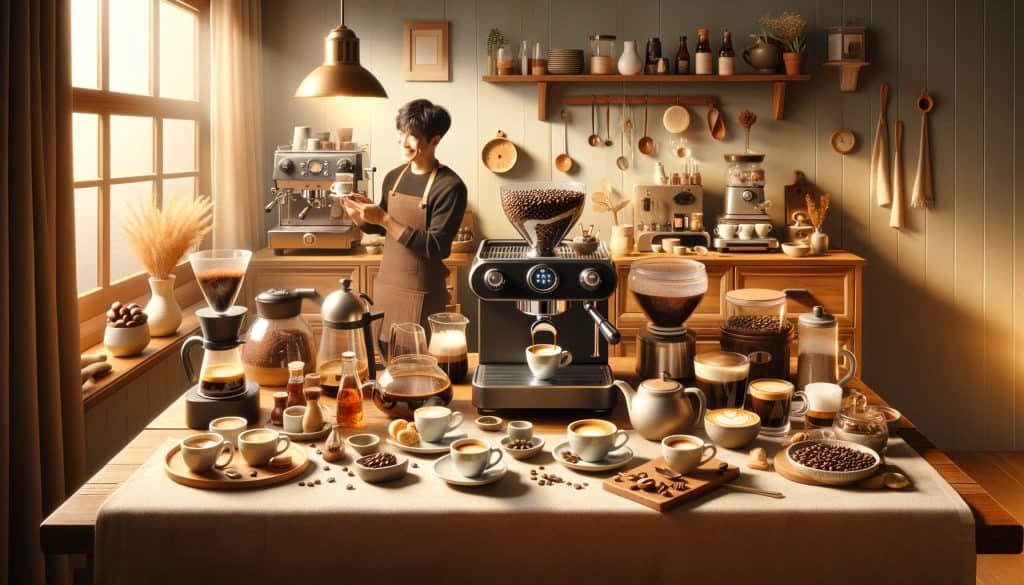There’s something magical about a perfectly brewed espresso that, when paired with the right food, can turn a simple coffee break into an exquisite tasting experience. Espresso, with its rich, complex flavors, can elevate a meal or a snack, creating a harmonious balance that delights the senses.
In this post, we’ll delve into the art of pairing espresso with food, aiming to guide you t ough creating successful pairings for home coffee tastings.
The Magic of Espresso and Food Pairings
Imagine this: a crisp morning, a warm, creamy espresso in hand, paired with a freshly baked croissant. The bitterness of the coffee balances the buttery sweetness of the pastry, creating a symphony of flavors.
This is the essence of a good espresso and food pairing. It’s not just about enjoying coffee and food side by side; it’s about how they interact with each other, enhancing and complementing the flavors.
Why Pair Espresso with Food?
- Enhanced Flavors: Espresso can enhance the taste of food, bringing out subtle flavors that you might not notice otherwise.
- Balanced Tasting Experience: A well-chosen pairing can balance the intensity of espresso, making it more palatable and enjoyable.
- Exploration of New Tastes: Pairing different foods with espresso allows you to experiment and discover new taste combinations.
- Social and Cultural Experience: Sharing a coffee and food pairing with friends or family can be a delightful social experience, steeped in cultural traditions.
Goals of This Post
This post aims to:
- Educate: Provide you with the knowledge needed to understand the basics of espresso and how its flavors can complement various foods.
- Inspire: Encourage you to experiment with different pairings and discover your personal favorites.
- Guide: Offer practical tips and suggestions for successful pairings that you can try at home.
Whether you’re a seasoned espresso enthusiast or just starting your journey into the world of coffee, this guide will help you create delightful pairings that bring out the best in both your espresso and your food. Let’s embark on this flavorful journey together!
< class="wp-block-separator has-alpha-channel-opacity"/>Understanding Espresso: The Basics

1. What is Espresso?
- Origin: Tracing back to Italy, espresso is more than just a coffee. It’s a brewing method where hot, pressurized water is forced t ough finely-ground coffee beans.
- Cultural Significance: Espresso is not just a drink; it’s a symbol of Italian culture, often enjoyed in social settings and as a daily ritual.
2. Characteristics of Espresso
- Flavor: Typically stronger and more concentrated than regular coffee. The flavor can vary based on the beans used, ranging from fruity and light to bold and rich.
- Aroma: The aroma of espresso is intense and captivating, often with hints of caramel, chocolate, or fruit, depending on the roast.
- Body: Espresso has a noticeable mouthfeel – it’s thicker than regular coffee due to the higher concentration of solids and oils extracted during brewing.
- Acidity: Good quality espresso should have a pleasant acidity that balances with its bitterness and body.
3. Types of Espresso Drinks
- Ristretto: A “short shot” with less water, leading to a more concentrated and bold flavor.
- Lungo: A “long shot” with more water, resulting in a less intense flavor.
- Espresso Macchiato: Espresso topped with a dollop of frothed milk.
- Cappuccino and Latte: Popular milk-based espresso drinks differing in milk-to-espresso ratios and foam layers.
4. The Art of Making Espresso
- Grind Size: The grind should be fine but not powdery.
- Tamping: Even and firm tamping is key to a good extraction.
- Temperature and Pressure: The water should be at about 90-96 degrees Celsius, and the machine should apply a pressure of 9 bars.
5. The Role of Equipment
- Espresso Machine: A good quality machine is crucial. It should be able to maintain consistent temperature and pressure.
- Grinder: The grinder is equally important as the machine. A burr grinder is preferred for its consistency.
6. Personalization and Experimentation
- Experiment with different beans, grind sizes, and extraction times to find your perfect espresso shot.
By understanding these basics, you can appreciate the complexity and artistry behind every cup of espresso. Whether you’re a seasoned barista or a home enthusiast, the world of espresso offers a rich experience to explore and enjoy.
< class="wp-block-separator has-alpha-channel-opacity"/>The Science of Taste and Flavor
Pairing espresso with food is not just about taste; it’s a science. Let’s dive into how this works:

How Taste Works: The Role of Taste Buds
Taste buds are tiny sensors in your mouth. They help you enjoy the flavors in food and drinks. When you sip espresso, your taste buds wake up. They notice if it’s sweet, sour, bitter, or even salty.
Taste Buds and Espresso Flavors
| Taste Bud Type | Common Sensation | Espresso Influence |
|---|---|---|
| Sweet | Sugar, Syrup | Highlights natural sweetness in coffee |
| Sour | Citrus, Vinegar | Detects acidity in espresso |
| Bitter | Bitter Greens | Senses the strong, bold flavors in espresso |
| Salty | Salt | Rare in espresso but balances other flavors |
Understanding Flavor Profiles
Flavors are more than just taste. They’re about the balance of sweet, sour, bitter, salty, and umami (a savory taste). Each espresso has its own flavor profile, which changes with different foods.
Espresso Flavor Profiles
- Sweet: Often found in lightly roasted espresso.
- Sour: Noted in under-extracted espresso shots.
- Bitter: A hallmark of over-extracted or dark roast espresso.
- Salty: Rare, but can add complexity.
- Umami: Rich, brothy, or meaty flavors, rare in espresso.
The Impact of Aroma in Food and Coffee Tasting
Aroma is a huge part of tasting. It’s about the smell that comes from your cup of espresso. When you smell something good, like freshly brewed coffee, it makes the taste even better.
Aroma Impact on Tasting
| Aroma Type | Description | Effect on Espresso Tasting |
|---|---|---|
| Floral | Flowery scents | Adds a light, delicate taste |
| Spicy | Cinnamon, nutmeg | Brings warmth and complexity |
| Fruity | Berries, citrus | Enhances natural sweetness |
| Nutty | Almonds, walnuts | Adds depth and richness |
| Chocolatey | Rich cocoa | Provides a smooth, luxurious taste |
Understanding these elements can transform your espresso and food pairing experience at home. It’s all about finding the right balance and enjoying the journey of flavors!
< class="wp-block-separator has-alpha-channel-opacity"/>Principles of Pairing Espresso with Food

Complementary vs. Contrasting Flavors
Pairing espresso with food is an art that balances flavors to enhance the tasting experience. There are two main approaches:
- Complementary Pairings: These pairings bring together flavors that harmonize and enhance each other. For example, a rich, chocolatey espresso can be paired with a sweet chocolate dessert, amplifying the cocoa notes in both.
- Contrasting Pairings: In contrast, contrasting pairings create a balance by combining opposing flavors. A bright, acidic espresso might pair well with a creamy, sweet dessert, balancing the acidity with sweetness.
Texture and Mouthfeel
Texture plays a crucial role in pairings. The mouthfeel of both the espresso and the food should complement each other. A smooth, velvety espresso can be paired with a crunchy biscotti, offering a delightful contrast in textures.
Balancing Intensity
The intensity of flavors in both the espresso and the paired food should be balanced. A strong, bold espresso might overpower a delicate, lightly flavored pastry. Instead, it could be paired with something equally robust, like a rich, dark chocolate cake.
| Espresso Type | Food Pairing | Flavor Profile | Texture | Intensity Balance |
|---|---|---|---|---|
| Ristretto | Dark Chocolate | Rich, Bold | Smooth | High |
| Lungo | Lemon Tart | Bright, Acidic | Crisp | Medium |
| Classic Espresso | Almond Biscotti | Nutty, Balanced | Crunchy | Medium-Low |
By understanding these principles, you can create delightful pairings that elevate your home coffee tastings, making each sip and bite a journey of flavors and textures.
< class="wp-block-separator has-alpha-channel-opacity"/>Classic Espresso and Food Pairings
Espresso and food pairings are an art form, combining the robust flavors of espresso with complementary food items. Here’s a guide to some classic pairings that can enhance your coffee tasting experience.

Traditional Italian Pairings
- Cannoli: The sweet, creamy filling of cannoli balances the intensity of a strong espresso.
- Tiramisu: The layers of coffee-soaked ladyfingers in tiramisu pair wonderfully with the rich espresso.
- Biscotti: Dip these crunchy, almond-flavored cookies into your espresso for a delightful taste.
Sweet Treats
- Chocolates: Dark chocolate, with its bitter notes, goes well with espresso. The combination intensifies the cocoa flavor.
- Pastries: Croissants and other light pastries offer a buttery contrast to the rich espresso.
- Desserts: Try espresso with desserts like chocolate cake or cheesecake for a luxurious treat.
Savory Options
- Cheeses: Aged cheeses like Parmesan or Gouda complement the bold flavors of espresso.
- Nuts: Almonds, hazelnuts, or walnuts add a crunchy, nutty element to your coffee tasting.
- Charcuterie: Salty meats like prosciutto or salami create an interesting contrast with the deep flavors of espresso.
Remember, the key to a successful pairing is balance. The intensity of the espresso should match the flavor profile of the food. This harmony enhances the tasting experience, making each sip and bite a delightful journey of flavors.
< class="wp-block-separator has-alpha-channel-opacity"/>Creative Pairing Ideas

Seasonal Pairings
Summer:
- Fruity Espresso: A shot of espresso paired with a slice of fresh, sweet watermelon or a bowl of mixed berries.
- Refreshing Combos: Light espresso blends with citrus-based salads or fruit tarts.
Autumn:
- Pumpkin Spice: Espresso with pumpkin pie or pumpkin-flavored treats.
- Apple Accents: Caramel apple slices or apple crumble alongside a robust espresso.
International Twists
- Asian Fusion: Sushi with a clean, crisp espresso to cleanse the palate.
- Mediterranean Moods: Tapas, like olives and cheese, with a bold espresso.
Vegetarian and Vegan Options
- Plant-Based Delights: Avocado toast or vegan wraps with a smooth, mild espresso.
- Sweet Vegan Treats: Vegan pastries or chocolate with a dark, rich espresso.
Pairing Tips
- Balance is Key: Ensure the intensity of the espresso matches the food.
- Experiment: Don’t be afraid to try unconventional combinations.
- Consider Mouthfeel: Pair creamy foods with a smooth espresso, or crispy bites with a sharp espresso.
Enjoy exploring these creative pairings and find your favorite flavors to enhance your home coffee tastings!
< class="wp-block-separator has-alpha-channel-opacity"/>Setting Up a Home Coffee Tasting
Hosting a home coffee tasting is a delightful way to explore the world of espresso and its myriad pairings. The key is to create an environment that enhances the experience, paying attention to detail, from brewing to presentation. Here’s how to make your coffee tasting a memorable event:

Essential Equipment and Setup
- Espresso Machine: The centerpiece of your tasting, an espresso machine should be capable of brewing rich, flavorful shots.
- Coffee Grinder: A good grinder is crucial for fresh, evenly ground beans, which is essential for a great espresso.
- Selection of Beans: Offer a variety, ranging from light to dark roasts, to showcase different flavor profiles.
Brewing the Perfect Cup
- Water Quality: Use filtered water for the best taste.
- Grinding: Grind beans just before brewing to maintain freshness.
- Temperature and Pressure: Ensure your espresso machine is properly calibrated for consistent quality.
Presentation Tips
- Serve in Small Cups: Espresso is best enjoyed in small quantities. Use demitasse cups for a traditional feel.
- Accessorize: Include a pitcher for steamed milk and an array of syrups or spices for guests to experiment with flavors.
- Ambiance: Create a warm, inviting space. Soft lighting, comfortable seating, and a touch of greenery can make a big difference.
A Memorable Tasting Experience
- Guided Tasting: Walk your guests t ough each espresso, discussing the origin, roast, and expected flavor notes.
- Pairing with Bites: Offer biscuits, chocolates, or other small treats that complement the espresso.
- Feedback and Discussion: Encourage guests to share their thoughts on each pairing, fostering a collaborative and enjoyable experience.
By focusing on these elements, you’ll ensure your home coffee tasting is not only about enjoying espresso but also about creating an experience that engages all the senses.
< class="wp-block-separator has-alpha-channel-opacity"/>Tasting Tips and Techniques

Introduction to Proper Tasting
Understanding how to taste espresso and food correctly enhances the experience. Here’s a guide to do it just right.
Sensory Engagement
- Visual Appeal: First, observe the color and texture of the espresso and food. Is the espresso rich and dark? Are the pastries flaky or moist?
- Aroma: Inhale deeply to identify different scents. Can you detect nutty, fruity, or floral notes in the espresso?
- Taste and Texture: Sip the espresso and let it coat your palate. Notice the balance between bitterness, acidity, and sweetness. How does the food’s texture complement the drink?
Taking Notes
- Record Impressions: Use a notebook to jot down initial thoughts. What stands out in the espresso’s flavor profile?
- Note Pairings: Document how different foods change or enhance the taste of the espresso. Did the chocolate bring out hidden notes?
Engaging All Senses
- Hearing: Listen to the sound of the espresso being poured. Does it change your anticipation of the taste?
- Touch: Feel the warmth of the cup, the texture of the food. How does this add to the experience?
Tasting espresso and food is an art that engages all your senses. By following these tips, you can uncover a world of flavors and create a memorable coffee tasting experience at home.
< class="wp-block-separator has-alpha-channel-opacity"/>Conclusion
The journey of exploring espresso and food pairings is both exciting and rewarding. From understanding the basics of espresso to experimenting with different flavor combinations, there’s a world of tastes to discover.

Remember, the key to successful pairings is balance. Complement or contrast flavors thoughtfully, considering the intensity and texture of both your espresso and food choices. Whether it’s a traditional Italian biscotti or a bold, international fusion, each pairing opens up new dimensions of flavor.
Setting up a home coffee tasting doesn’t require professional expertise. With the right equipment, some basic knowledge, and a willingness to experiment, anyone can create memorable tasting experiences. It’s not just about the taste; it’s about engaging all your senses, taking notes, and enjoying the nuances of each pairing.
Hosting a coffee tasting event at home can be a delightful way to connect with friends and family. Choose a theme, prepare a variety of pairings, and enjoy the shared experience of discovering new flavors together.
As we wrap up, I encourage you to continue experimenting with different espresso and food combinations. Share your experiences, learn from others, and most importantly, enjoy the journey of taste exploration. There’s always something new to discover in the world of espresso pairings!


